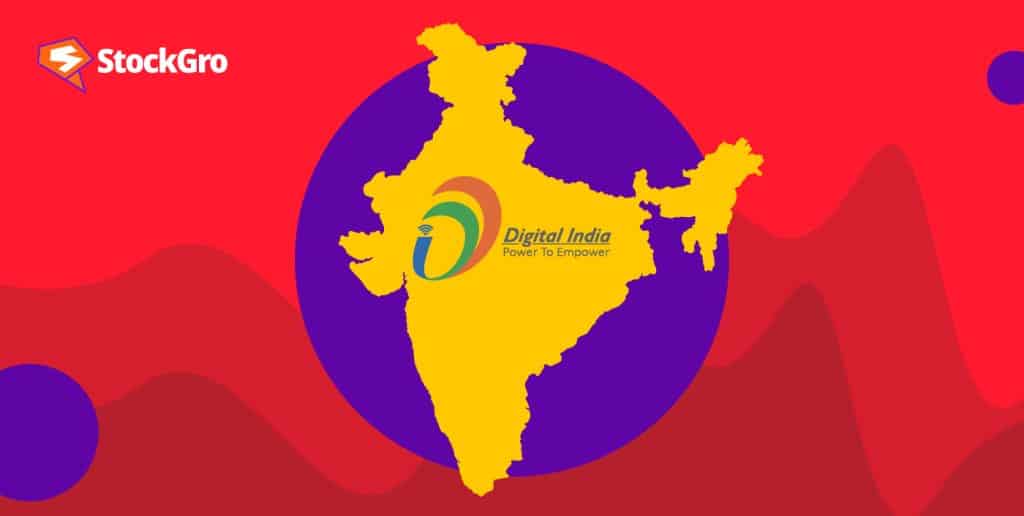
Having information is power in the digital era. But, the digital divide separates people with access to computers and the internet from those without it. India, a country with a large population and huge economic disparities, however is faced with different challenges.
Here, the successful implementation of the Digital India scheme, a government initiative in India, has the potential to give hope for such an effort and create a digitally inclusive society and knowledge economy.
Let us read more about the Digital India scheme.
What is the Digital India scheme?
Having one of the largest user bases with about 820 million users, the internet has seen rapid development in India, leading to changes in all walks of life, such as work, personal life, and business.
However, reaching all-out access to the internet is still a dream due to challenges such as infrastructure deficit, high costs, and poor digital literacy in specific segments. In response, the government initiated the Digital India campaign.
The Digital India scheme launch date was July 2015. It is a program aimed at remodelling online infrastructure and providing digital facilities in every nook and corner of the country, especially in remote centres, thus creating a more digitally inclusive society.
The program includes various projects like mobile e-health services, e-governance, and digital finance.
The efforts of the government, which focus on creating a fully digital economy, are envisaged to bring benefits across sectors.
Also read: The Law of Digital Signature
Vision – Digital India scheme
The digital India scheme has three vision areas:
- To ensure every citizen has access to digital infrastructure.
- To ensure governance and services are readily available on demand.
- To empower citizens through digital means.
Objectives – Digital India scheme
Digital India scheme’s primary objective is to transform India across several key vision areas – aiming to create a digitally empowered society and a knowledge economy. By improving technological infrastructure, enhancing services and resources, increasing tech literacy, and fostering an innovative digital ecosystem, this can be achieved.
The campaign’s specific objectives include:
- To establish a clear and comprehensive vision by harmonising diverse viewpoints, where each component strengthens the overall impact.
- To ensure high-speed internet connectivity in all gram panchayats.
- To restructure existing schemes for synchronised implementation.
- To ensure easy access to Common Service Centres in every locality.
The campaign encompasses various projects designed to increase internet connectivity, build technological infrastructure, promote the use of technologies for service delivery, and improve e-literacy.
It focuses on nine pillars:
- Broadband highways
- Public internet access programme
- Electronic delivery of services (e-Kranti)
- Universal access to mobile connectivity
- Early harvest programmes
- E-governance project
- IT for jobs
- Electronics manufacturing and
- Information for all
Digital India scheme initiatives
Here are some of the Digital India initiatives:
| Initiative | Description | Current Status |
| MyGov | A digital platform is provided for discussing matters between government and citizens online; it was started in 2014. | Over 30.0 million users are registered. |
| Aadhaar | It allocates a unique 12-digit number that is based on demographics and biometrics to each Indian resident. | The Aadhaar Act 2016 was introduced to give Aadhaar statutory backing. |
| DigiLocker | It verifies and stores certificates or essential documents on this platform launched in 2015. | Current users of DigiLocker are estimated at approximately 289.53 million. |
| Common Service Centres (CSCs) | Over 400 digital government and business services are brought directly to rural communities through a network of CSCs. | As of March 2024, over 570,000 CSCs were active, facilitating a total of 381.2 lakh transactions. |
| Smart Cities | This forward-looking initiative aims to reshape Indian cities into tech-centric centres (it began in 2015). | Between 2019 and 2023 – 100 cities have been chosen for targeted and comprehensive development. |
| BharatNet | In 2012, it was introduced and renamed in 2015. This initiative is about rural connectivity, with the aim of linking all India’s 250,000 gram panchayats together using high speed internet (100 Mbps). | By January 2024, large strides have been made with about 210,000 gram panchayats now being service ready. |
| UPI | It is the leading digital payment platform. | In FY24, India recorded about 131 billion UPI transactions. |
| Public Wi-Fi Hotspots | The effort aimed at creating public Wi-Fi spots, thereby making access possible even without mobile data usage. | However only half a million hotspots were established across India by December 2022 compared to the target of ten million. |
| e-Health | The initiative sought to provide timely and effective healthcare services, including online registrations, reports, payments, and claims. | As of January 2024, 381.8 million patients were registered, with 29.6 million admissions across India. |
| E-education | The initiative was launched to provide online education to urban and remote areas using technologies such as apps, smartphones, and internet services. | In May 2020, the government introduced PM eVIDYA, a program aimed at offering multimode access to digital and online education. According to the Union Budget 2021-22, approximately 5.6 million teachers were trained under the NISHTHA training program in FY22. |
Source: IBEF
Must read: Blue Aadhaar Card: Who is it for, and how to apply?
Challenges of Digital India scheme
The Digital India scheme has several challenges despite all its achievements:
- The infrastructure gap: The gap in internet connectivity and digital infrastructure between urban and rural areas is a significant challenge that remains. There have been some successes, such as BharatNet; however, this coverage needs to be made more comprehensive.
- Digital literacy: Digital literacy levels among remote and marginalised societies hampers the effective use of digital services and technologies.
- Privacy concerns: It is essential to safeguard data privacy in the virtual world. There should be strict privacy laws accompanying the adoption of digital services with mechanisms for protecting personal users’ details.
You may also like: Financial literacy advocacy: A beacon of hope for underserved communities
Conclusion
India’s Digital India scheme is a game changer that aims at closing the gap by using technology to transform lives. Through this programme, much has been achieved in improving digital infrastructure. Thus, enhancing digital literacy and developing the digital economy.
Even though progress towards closing the digital divide is ongoing, the Digital India scheme acts as a ray of hope and progress, exemplifying how technology can be used to drive socio-economic development across the country benefiting millions.

